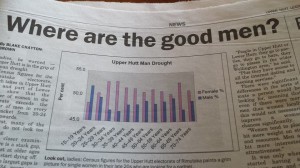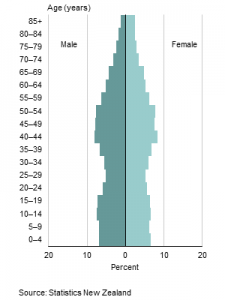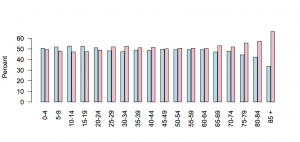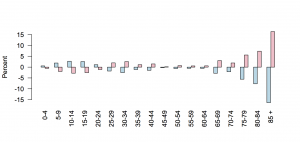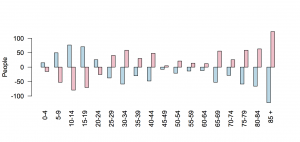The Lesser Spotted Hutt Man Drought
From the Christmas Eve edition of the Upper Hutt Leader, which you can read online:
Ladies, be warned — Upper Hutt is in the grip of a man drought
Here’s the graph to prove it (via Richard Law, on Twitter)
As the graph clearly indicates, women outnumber men hugely in the 25-35 age range, and (of course) at the oldest ages. The problem is, the y-axis starts at 45%. For lines or points that’s fine, but for bar charts it isn’t — because the bars connect the points to the x-axis.
This is Stats New Zealand’s version of the graph, in standard ‘population pyramid’ form. It’s much less dramatic.
We could try a barchart with axis at zero
It’s still much less dramatic — and you can see why the paper chopped the ages off at 75, since using the full range available in the data wouldn’t have fit on their axes. The y-axis wasn’t just trimmed to fit the data; it was trimmed beyond the data.
You could make a case that ‘zero’ in this example is actual 50%: we (well, not we, but journalists who have to fill space) care about the deficiency or surplus of members of the appropriate sex.
Or, you could look at deficiency or surplus of individuals, rather than percentages
Using individuals makes the younger age groups look more important, which helps the story, but on the other hand shows that the scale of this natural disaster isn’t all that devastating.
That’s basically what the expert quoted in the story says. Prof Garth Fletcher, from VUW, says
“People in Upper Hutt or Lower Hutt, they go to parties, they go to bars, they go to places in the wider Wellington area.”
…
It was only when you started having a gap between men and women of more than 5 or 10 percent that there would be real world implications, he said.
[Update: My data and graphs are for Upper Hutt (city). That’s about 2/3 of the Rimutaka electorate, which is where the paper’s data are for]
Thomas Lumley (@tslumley) is Professor of Biostatistics at the University of Auckland. His research interests include semiparametric models, survey sampling, statistical computing, foundations of statistics, and whatever methodological problems his medical collaborators come up with. He also blogs at Biased and Inefficient See all posts by Thomas Lumley »
